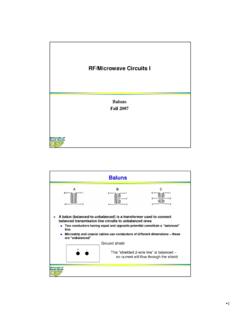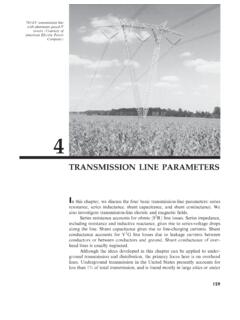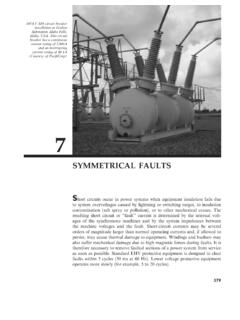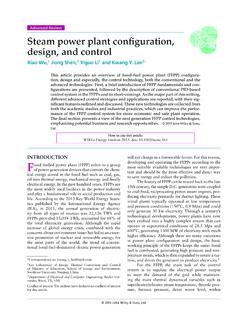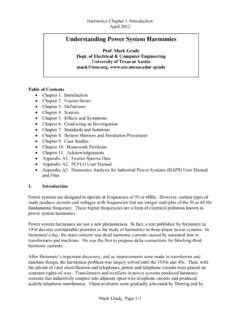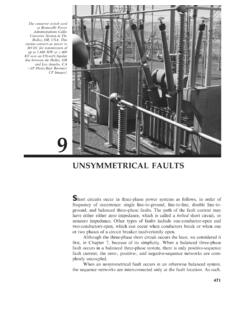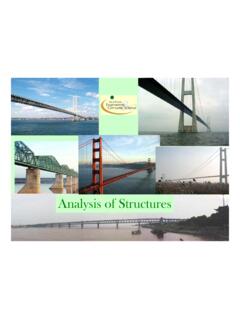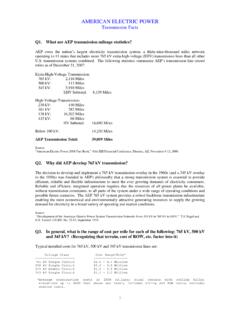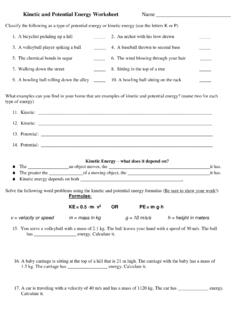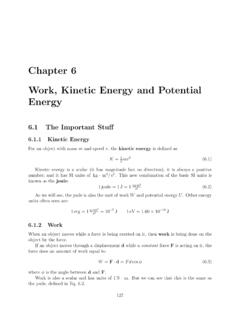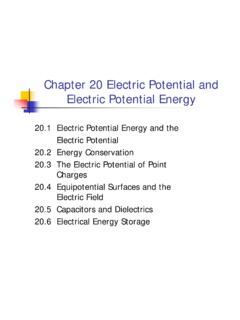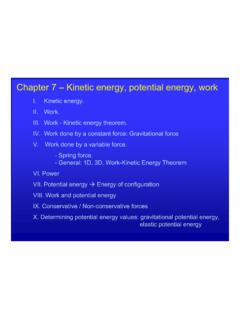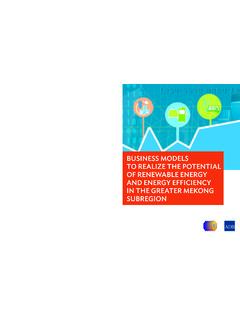Transcription of Potential energy - Baylor University
1 Potential energy1 Potential energyPotential energyIn the case of a bow and arrow, the energy is converted from the Potential energy in the archer's arm to the Potential energy in thebent limbs of the bow when the string is drawn back. When the string is released, the Potential energy in the bow limbs istransferred back through the string to become kinetic energy in the arrow as it takes symbol(s):PE or USI unit:joule (J)Derivations from other quantities:U = m g h (gravitational)U = k x2 (elastic)U = C V2 / 2 (electric)U = -m B (magnetic)In physics, Potential energy is the energy of an object or a system due to the position of the body or the arrangementof the particles of the system.[1] The SI unit for measuring work and energy is the Joule (symbol J).The term " Potential energy " was coined by the 19th century Scottish engineer and physicist William Rankine,[2][3]although it has links to Greek philosopher Aristotle's concept of energy is associated with a set of forces that act on a body in a way that depends only on the body's positionin space.
2 This allows the set of forces to be considered as having a specified vector at every point in space formingwhat is known as a vector field of forces, or a force field. If the work of forces of this type acting on a body thatmoves from a start to an end position is defined only by these two positions and does not depend on the trajectory ofthe body between the two, then there is a function known as a Potential that can be evaluated at the two positions todetermine this work. Furthermore, the force field is defined by this Potential function, also called Potential energy is often associated with restoring forces such as a spring or the force of gravity. The action ofstretching the spring or lifting the mass is performed by an external force that works against the force field of thepotential. This work is stored in the force field, which is said to be stored as Potential energy .
3 If the external force isremoved the force field acts on the body to perform the work as it moves the body back to the initial position,reducing the stretch of the spring or causing a body to more formal definition is that Potential energy is the energy difference between the energy of an object in agiven position and its energy at a reference are various types of Potential energy , each associated with a particular type of force. More specifically, every conservative force gives rise to Potential energy . For example, the work of an elastic force is called elastic Potential energy ; work of the gravitational force is called gravitational Potential energy ; work of the Coulomb force is called electric Potential energy ; work of the strong nuclear force or weak nuclear force acting on the baryon charge is calledPotential energy2nuclear Potential energy ; work of intermolecular forces is called intermolecular Potential energy .
4 Chemical potentialenergy, such as the energy stored in fossil fuels, is the work of the Coulomb force during rearrangement of mutualpositions of electrons and nuclei in atoms and molecules. Thermal energy usually has two components: the kineticenergy of random motions of particles and the Potential energy of their mutual a general rule, the work done by a conservative force F will bewhere is the change in the Potential energy associated with that particular force. Common notations forpotential energy are U, V, and and Potential energyThe work of a force acting on a moving body yields a difference in Potential energy when the integration of the workis path independent. The scalar product of a force F and the velocity v of its point of application defines the powerinput to a system at an instant of time. Integration of this power over the trajectory of the point of application,C=x(t), defines the work input to the system by the the work for an applied force is independent of the path, then the work done by the force is evaluated at the startand end of the trajectory of the point of application.
5 This means that there is a function U (x), called a " Potential ,"that can be evaluated at the two points x(t1) and x(t2) to obtain the work over any trajectory between these twopoints. It is tradition to define this function with a negative sign so that positive work is a reduction in the Potential ,that isThe function U(x) is called the Potential energy associated with the applied force. Examples of forces that havepotential energies are gravity and spring this case, the partial derivative of work yieldsand the force F is said to be "derivable from a Potential ."[4]Because the Potential U defines a force F at every point x in space, the set of forces is called a force field. The powerapplied to a body by a force field is obtained from the gradient of the work, or Potential , in the direction of thevelocity V of the body, that isExamples of work that can be computed from Potential functions are gravity and spring forces.
6 [5] Potential function for near earth gravityGravity exerts a constant downward force F=(0, 0, W) on the center of mass of a body moving near the surface of theearth. The work of gravity on a body moving along a trajectory X(t) = (x(t), y(t), z(t)), such as the track of a rollercoaster is calculated using its velocity, V=(vx, vy, vz), to obtainwhere the integral of the vertical component of velocity is the vertical distance. Notice that the work of gravitydepends only on the vertical movement of the curve X(t).The function U(x)=mgh is called the Potential energy of a near earth gravity energy3 Potential function for a linear springA horizontal spring exerts a force F=(kx, 0, 0) that is proportional to its deflection in the x direction. The work of thisspring on a body moving along the space curve X(t) = (x(t), y(t), z(t)), is calculated using its velocity, V=(vx, vy, vz),to obtainFor convenience, consider contact with the spring occurs at t=0, then the integral of the product of the distance x andthe x-velocity, xvx, is (1/2) function U(x)= 1/2 kx2 is called the Potential energy of a linear levelThe Potential energy is a function of the state a system is in, and is defined relative to that for a particular state.
7 Thisreference state is not always a real state, it may also be a limit, such as with the distances between all bodies tendingto infinity, provided that the energy involved in tending to that limit is finite, such as in the case of inverse-squarelaw forces. Any arbitrary reference state could be used, therefore it can be chosen based on the Potential energy of a system depends on the relative positions of its components only, so the referencestate can also be expressed in terms of relative Potential energyGravitational energy is the Potential energy associated with gravitational force, as work is required to elevate objectsagainst Earth's gravity. The Potential energy due to elevated positions is called gravitational Potential energy , and isevidenced by water in an elevated reservoir or kept behind a dam. If an object falls from one point to another pointinside a gravitational field, the force of gravity will do positive work on the object, and the gravitational potentialenergy will decrease by the same force keeps the planets in orbitaround the a book placed on top of a table.
8 As the book is raised fromthe floor, to the table, some external force works against thegravitational force. If the book falls back to the floor, the "falling" energy the book receives is provided by the gravitational force. Thus, ifthe book falls off the table, this Potential energy goes to accelerate themass of the book and is converted into kinetic energy . When the bookhits the floor this kinetic energy is converted into heat and sound by factors that affect an object's gravitational Potential energy are itsheight relative to some reference point, its mass, and the strength of thegravitational field it is in. Thus, a book lying on a table has less gravitational Potential energy than the same book ontop of a taller cupboard, and less gravitational Potential energy than a heavier book lying on the same table. Anobject at a certain height above the Moon's surface has less gravitational Potential energy than at the same heightabove the Earth's surface because the Moon's gravity is weaker.
9 Note that "height" in the common sense of the termcannot be used for gravitational Potential energy calculations when gravity is not assumed to be a constant. Thefollowing sections provide more energy4A trebuchet uses the gravitational potentialenergy of the counterweight to throw projectilesover long approximationThe strength of a gravitational field varies with location. However,when the change of distance is small in relation to the distances fromthe center of the source of the gravitational field, this variation in fieldstrength is negligible and we can assume that the force of gravity on aparticular object is constant. Near the surface of the Earth, for example,we assume that the acceleration due to gravity is a constant g = ("standard gravity"). In this case, a simple expression forgravitational Potential energy can be derived using the W = Fdequation for work, and the equationThe amount of gravitational Potential energy possessed by an elevated object is equal to the work done againstgravity in lifting it.
10 The work done equals the force required to move it upward multiplied with the vertical distanceit is moved (remember W = Fd). The upward force required while moving at a constant velocity is equal to theweight, mg, of an object, so the work done in lifting it through a height h is the product mgh. Thus, when accountingonly for mass, gravity, and altitude, the equation is:[6]where U is the Potential energy of the object relative to its being on the Earth's surface, m is the mass of the object, gis the acceleration due to gravity, and h is the altitude of the object.[7] If m is expressed in kilograms, g in meters persecond squared and h in meters then U will be calculated in , the Potential difference isGeneral formulaHowever, over large variations in distance, the approximation that g is constant is no longer valid, and we have touse calculus and the general mathematical definition of work to determine gravitational Potential energy .
